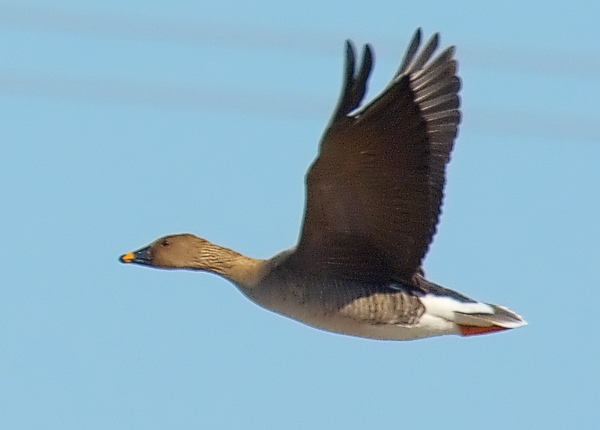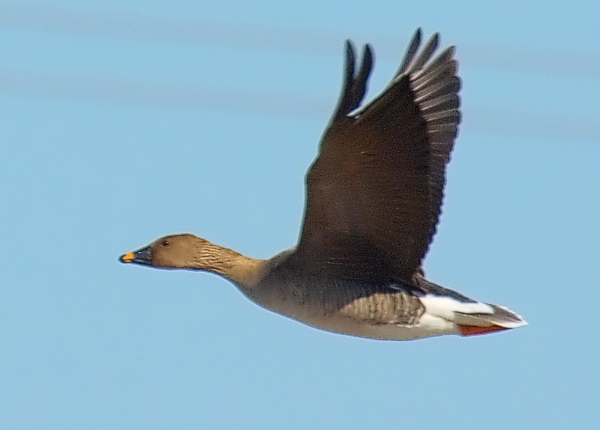Are these bean geese merging into one species or not?
“I’ve been following your progress into the world of bird speciation and I wondered whether you’d be interested in a proposal.” This was the first sentence of an e-mail from Joe Tobias that I received in December 2019. He had been invited to write a review on bird diversification for the journal Annual Reviews in Ecology, Evolution, and Systematics and was looking for co-authors to write some sections. The only catch: the deadline was approaching fast (19th of January 2020). I did not have to think long about my decision, this was a great opportunity to work with one of the leading scientists in avian research and publish in one of my favorite journals. Moreover, I enjoy writing and I am always up for a challenge. A few days later, Alex Pigot joined the writing team and together we produced an extensive review that recently appeared online: “Avian Diversity: Speciation, Macroevolution, and Ecological Function“.
Road Trip along the Speciation Cycle
The resulting review paper centered around the concept of the speciation cycle (see figure below) which involves a series of evolutionary and ecological events. First, populations become geographically isolated and diverge in allopatry. When these populations establish secondary contact, several scenarios are possible. They might be reproductively isolated and transition into sympatry (and the cycle can start again). Or they might still be able to hybridize and establish a hybrid zone. The dynamics in these hybrid zones consequently determine the next phase in the speciation cycle. If hybrids are unfit – for instance, sterile or unable to find a mate – selection against hybrids can lead to character displacement, leading to further differentiation between the hybridizing species that eventually transition to sympatry. Alternatively, hybridization levels are so high that the populations collapse into one species. Regardless of the outcome (sympatry or collapse), the cycle can start again.

The different phases of the speciation cycles. The colored circles surrounding the diagram indicate different fields of research that are relevant to specific phases. From: Tobias et al. (2020) Annual Review in Ecology, Evolution, and Systematics.
Crossroads
The review paper elaborates on numerous interesting aspects of the speciation cycle. In this blog post, however, I want to focus on one particular point in this cycle: the crossroads at the hybrid zone phase. Will the populations transition into sympatry or will they merge into one species? One of my recent papers, published in the journal Heredity, provides a nice case study of this situation. During my postdoc at Uppsala University (Sweden), I studied the evolutionary history of the taiga bean goose (Anser fabalis fabalis) and the tundra bean goose (Anser fabalis serrirostris). Using whole genome resequencing data, I reconstructed their evolution history and tried to understand the genetic make-up of these birds.
It turned out that these geese diverged about 2.5 million years ago in allopatry and came into secondary contact ca. 60,000 years ago. Their genomes are largely undifferentiated but a few genomic regions – so-called ‘islands of differentiation’ – stand out. These islands might contain genes that contribute to reproductive isolation. For example, we found the gene KCNU1 which is involved in spermatogenesis. However, other evolutionary forces, such as background selection, can also give rise to these islands of differentiation. These results raise an important question: Are taiga and tundra bean goose now merging into one species?

A strolling taiga bean goose © Marton Berntsen | Wikimedia Commons
Merging or Diverging?
Which path of the speciation cycle the bean geese will follow, is difficult to predict. I suspect that these two populations have been stuck in a cycle of merging and diverging for thousands of years. With the genomic analyses, we managed to capture the latest merging event about 60,000 years ago. More powerful techniques might be able to find evidence for older hybridization events. In the future, taiga and tundra bean goose might start diverging again, possibly driven by the differences in the genetic islands of differentiation that we uncovered. However, if levels of hybridization increase, they might collapse into one species. Clearly, they are at an important crossroads in their evolution and future studies will reveal which turn they eventually took.
The current situation complicates the taxonomy of the bean geese. Should they be considered separate species or are they better classified as subspecies? Personally, I find this discussion nonsensical and uninteresting. Taiga and tundra bean goose are obviously in the grey zone of the speciation continuum where subjective taste determines their taxonomic status. Although I was a bit reluctant to enter this discussion, my co-authors and the reviewers advised me to discuss the taxonomy of the bean geese in the paper. So, based on low genetic differentiation, considerable morphological variation and incomplete reproductive isolation, we argued that taiga and tundra bean goose should be treated as subspecies.

A tundra bean goose flying over Sweden. © Stefan Berndtsson | Wikimedia Commons
Trivial Taxonomy
This conclusion struck a chord with some birdwatchers, who reacted furiously to the taxonomic recommendations (even though they were only a minor part of the study) on Twitter. One random birder – who would not recognize a DNA-sequence if it hit him in the face – even had the audacity to question how the paper made it through peer review. Just because you disagree with a certain conclusion, doesn’t mean that you should trash the entire study. To use a common saying: Don’t throw the baby out with the bathwater! Instead of reacting in the same manner as the birdwatchers, I did not lower myself to their level and politely explained the reasoning behind my conclusions (which you can also find in the paper).
Unfortunately, the unnuanced and emotional responses of these birdwatchers reflect the current level of discourse in our society, especially on social media. When someone doesn’t agree with the statement of a particular person, they immediately vilify everything about that person. I hope this style of discussion does not find its way into science and we can continue to carefully consider each others arguments, culminating in a strong consensus or at least politely agree to disagree.
But to end on a positive note: there was also a nice discussion on the website Dutch Birding about the taxonomy of the Bean Geese. In contrast to the blunt messages on Twitter, several birders provided constructive feedback. It is possible!
References
Ottenburghs, J., Honka, J., Muskens, G. & Ellegren, H. (2020) Recent introgression between Taiga Bean Goose and Tundra Bean Goose results in a largely homogeneous landscape of genetic differentiation. Heredity. 125: 73–84.
Tobias, J.A., Ottenburghs, J. & Pigot, A. (2020) Avian Diversity: Speciation, Macroevolution, and Ecological Function. Annual Review of Ecology, Evolution and Systematics. Early View.


[…] as species or subspecies are secondary to more interesting evolutionary questions. As I have argued before, instead of focusing on minor morphological differences to draw arbitrary lines between […]
[…] on the evolutionary history of these birds (as I have explained in previous blog posts, such as here and here). However, an unstable taxonomy often indicates that something interesting is going on. A […]
[…] Imagine going for a walk through a mountainous region. You work your way up steep slopes, venture into valleys and stroll across expansive plateaus. You don’t even have to go outdoors to explore such heterogenous landscapes, just sequence a few genomes and compare the level of genetic differentiation of two species along these seemingly endless stretches of A, T, C and Gs. Indeed, numerous studies have described a heterogenous genomic landscape with highly divergent mountains and undifferentiated valleys. I have made my modest contribution to this field of research by exploring the genomic landscape of two goose taxa (you can read the whole story here). […]
[…] to my recent paper on the evolution of taiga and tundra bean goose (which I covered in this blog post). Using whole genome re-sequencing data, we found low genetic divergence (Fst = 0.033) and high […]
[…] in other avian systems, such as Hooded Crow (Corvus cornix) and Carion Crow (C. corone) or Taiga Bean Goose (Anser fabalis) and Tundra Bean Goose (A. serrirostris). A few divergent genomic regions seem to be sufficient for a high level of reproductive isolation. […]
[…] The earliest studies interpreted these patterns in the context of speciation-with-gene-flow, suggesting that these genomic islands contain loci that contribute to reproductive isolation. When two species interbreed, these barrier loci are expected to be immune to introgression. Hence, they will diverge while the remainder of the genome is homogenized by introgression. This explanation might apply to some study systems, such as bean geese. […]
[…] on the evolutionary history of these birds (as I have explained in previous blog posts, such as here and […]
[…] the process of speciation – or even subject to reverse speciation, such as American crows and bean geese – end up in a taxonomic grey zone where species criteria come into conflict. Classifying the […]
[…] our story does not end here. In a previous study – published in Heredity and covered in this blog post – we found extensive introgression between Taiga and Tundra Bean Goose. When we tested for […]